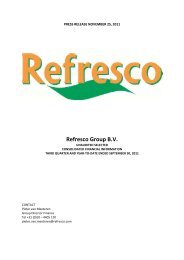measure and monitor the processes and report results ... - Refresco.de
measure and monitor the processes and report results ... - Refresco.de
measure and monitor the processes and report results ... - Refresco.de
You also want an ePaper? Increase the reach of your titles
YUMPU automatically turns print PDFs into web optimized ePapers that Google loves.
Financial review 2010<br />
3 Financial risk management<br />
3.1 Financial risk<br />
The Group has exposure to <strong>the</strong> following risks as regards its<br />
use of financial instruments:<br />
•<br />
•<br />
•<br />
Credit risk<br />
Liquidity risk<br />
Market risk<br />
This note provi<strong>de</strong>s information regarding <strong>the</strong> exposure of<br />
<strong>the</strong> Group to each of <strong>the</strong> above risks, <strong>the</strong> objectives, policies<br />
<strong>and</strong> <strong>processes</strong> for measuring <strong>and</strong> managing risk, <strong>and</strong> <strong>the</strong><br />
management of capital. Fur<strong>the</strong>r quantitative disclosures are<br />
inclu<strong>de</strong>d throughout <strong>the</strong>se consolidated financial statements.<br />
The Executive Board has <strong>the</strong> responsibility for <strong>the</strong><br />
establishment <strong>and</strong> oversight of <strong>the</strong> risk management<br />
framework of <strong>the</strong> Group.<br />
Risk management policies of <strong>the</strong> Group are established to<br />
i<strong>de</strong>ntify <strong>and</strong> analyze <strong>the</strong> risks faced by <strong>the</strong> Group, to set<br />
appropriate risk limits <strong>and</strong> controls, <strong>and</strong> to <strong>monitor</strong> risks <strong>and</strong><br />
adherence to limits. Risk management policies <strong>and</strong> systems are<br />
reviewed regularly to reflect changes in market conditions <strong>and</strong><br />
in <strong>the</strong> activities of <strong>the</strong> Group. Through its training program <strong>and</strong><br />
its management st<strong>and</strong>ards <strong>and</strong> procedures, <strong>the</strong> Group aims to<br />
<strong>de</strong>velop a disciplined <strong>and</strong> constructive control environment in<br />
which all employees un<strong>de</strong>rst<strong>and</strong> <strong>the</strong>ir roles <strong>and</strong> responsibilities.<br />
The Supervisory Board oversees management’s <strong>monitor</strong>ing of<br />
compliance with <strong>the</strong> risk management policies <strong>and</strong> procedures<br />
of <strong>the</strong> Group <strong>and</strong> it reviews <strong>the</strong> a<strong>de</strong>quacy of <strong>the</strong> risk management<br />
framework in relation to <strong>the</strong> risks faced by <strong>the</strong> Group.<br />
3.1.2 Credit risk<br />
Credit risk represents <strong>the</strong> risk that counter parties fail to meet<br />
<strong>the</strong>ir contractual obligations, <strong>and</strong> arises principally in <strong>the</strong><br />
receivables from customers, cash <strong>and</strong> cash equivalents,<br />
<strong>de</strong>rivative financial instruments <strong>and</strong> <strong>de</strong>posits with banks <strong>and</strong><br />
financial institutions. The Group does not have any significant<br />
concentration of credit risk. In or<strong>de</strong>r to reduce <strong>the</strong> exposure<br />
to credit risk, <strong>the</strong> Group carries out ongoing credit evaluations<br />
of <strong>the</strong> financial position of customers but generally does not<br />
require collateral. Use is ma<strong>de</strong> of a combination of in<strong>de</strong>pen<strong>de</strong>nt<br />
ratings <strong>and</strong> risk controls to assess <strong>the</strong> credit quality of <strong>the</strong><br />
customer, taking into account its financial position, past<br />
experience <strong>and</strong> o<strong>the</strong>r factors. Sales are subject to payment<br />
conditions which are common practice in each country.<br />
The banks <strong>and</strong> financial institutions used as counterparty<br />
for holding cash <strong>and</strong> cash equivalents <strong>and</strong> <strong>de</strong>posits <strong>and</strong> in<br />
<strong>de</strong>rivative transactions can be classified as high credit quality<br />
financial institutions (minimal: A rating).<br />
The Group has policies that limit <strong>the</strong> amount of credit exposure<br />
to individual financial institutions. Management believes that<br />
<strong>the</strong> likelihood of losses arising from credit risk is remote<br />
particularly in <strong>the</strong> light of <strong>the</strong> diversification of activities.<br />
3.1.3 Liquidity risk<br />
Liquidity risk is <strong>the</strong> risk that <strong>the</strong> Group will not be able to meet<br />
its financial obligations as <strong>the</strong>y fall due. The approach of <strong>the</strong><br />
Group to managing liquidity risk is to ensure, as far as possible,<br />
that it always has sufficient liquidity to meet its liabilities when<br />
due, un<strong>de</strong>r both normal <strong>and</strong> more extreme conditions, without<br />
incurring unacceptable losses or risking damage to <strong>the</strong><br />
reputation of <strong>the</strong> Group.<br />
The Group has a clear focus on financing longterm growth<br />
as well as current operations. Strong cost <strong>and</strong> cash<br />
management <strong>and</strong> controls over working capital <strong>and</strong> capital<br />
expenditure proposals are in place to ensure effective <strong>and</strong><br />
efficient allocation of financial resources.<br />
3.1.4 Market risk<br />
Currency risk<br />
The Group is exposed to currency risk mainly on purchases<br />
<strong>de</strong>nominated in USD. At any point in time <strong>the</strong> Group hedges 80<br />
to 100 percent of its estimated foreign currency exposure on<br />
forecasted purchases for <strong>the</strong> following 12 months. The Group<br />
uses currency option contracts <strong>and</strong> forward exchange contracts<br />
to hedge its currency risks, most of which have a maturity date<br />
of less than one year from <strong>the</strong> <strong>report</strong>ing date. Where necessary,<br />
forward exchange contracts are rolled over on maturity.







